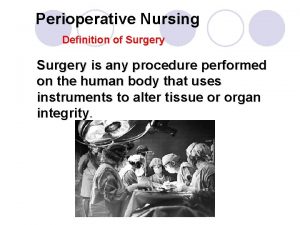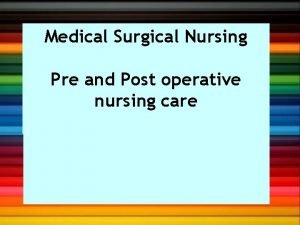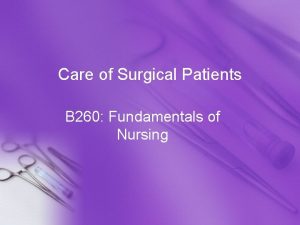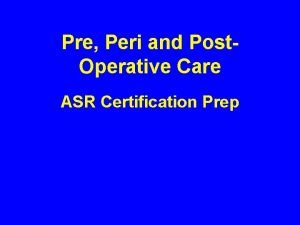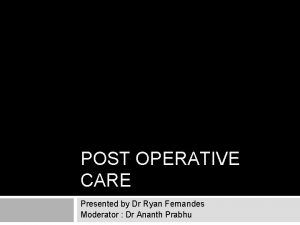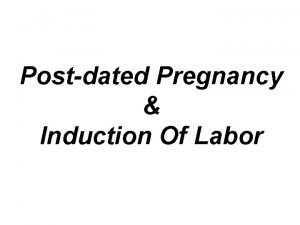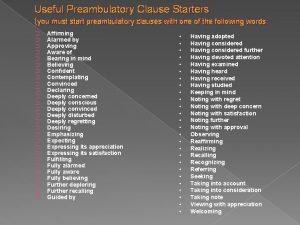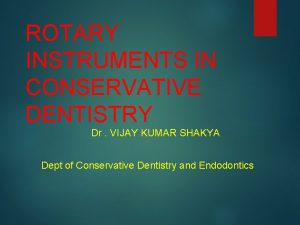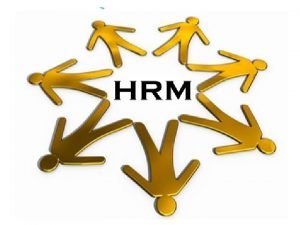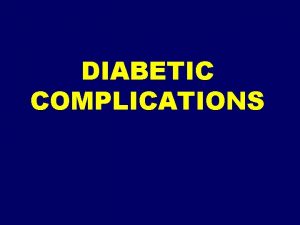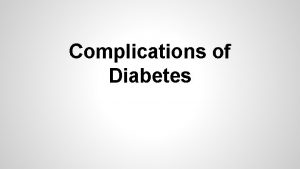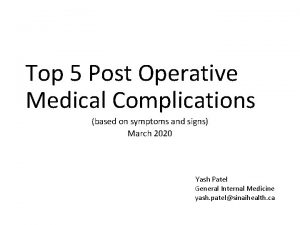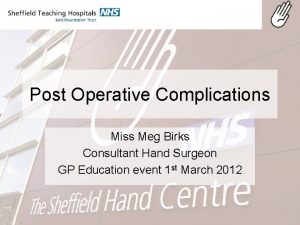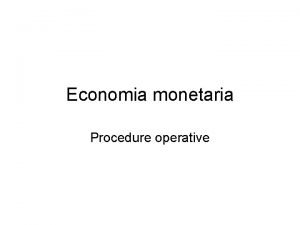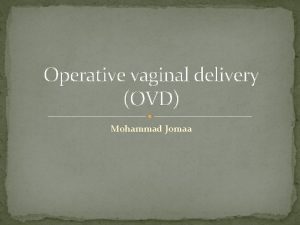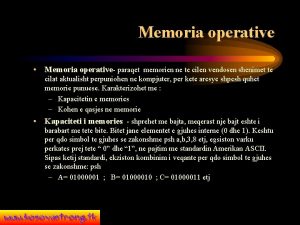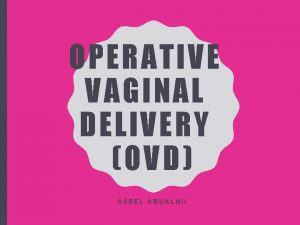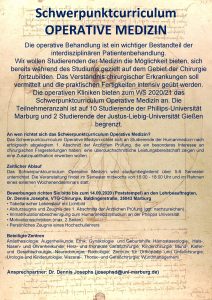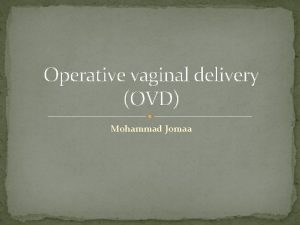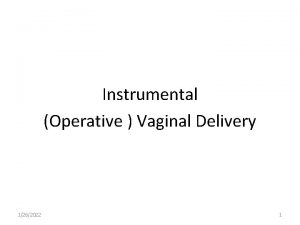Post operative complications Classification 1 Specific to operation

























- Slides: 25

Post operative complications Classification 1. Specific to operation 2. General ( Immediate early late)

E. G Complication of a Bowel Resection for colon ca Specific Intraoperative Haemorrhage -Wound infection -Anastomotic leak -Intra-abd. abscess Adhesion -Stricture - hernia General to anaeshesia -MI -Pumonary - PE -Anaphylactic Reaction collapse -DVT -Cannula - UTI phlebitis

Common clinical presentation 1. n n n Low urine output (oligo-anuria) Urine output is a reflection of GFR which is a reflection of RBF hence hydration Surgery produces the stress response. Which leads to decreased urine volume. Other factors can affect GFR not just RBF

n n Min. acceptable urine output is 0. 5 ml/kg Important to act on urine output to avoid tubular damage and necrosis hence acute renal failure

Patient has oligo-anuria Catheterize If catheter ? retention flush If real oligo - anuria Check for low Cardiac output Assess for signs of hypovolaemia

Treat causes of Low cardiac output (e. g arrhythmias) trial of fluid Challenge bolus up to 5 ml/kg Consider icu support if failed consider further challenge monitored by cvp

Advanced therapies 1. Furosemide 2. Dopamine 3. Renal support – indication water k+ urea (to toxic bwels) failure to regulate acid-base

2 - Confusion (D. A. M HYPOS) Drugs - Anaesthetic agents n - Analgesics (opiates) - Normal drugs being given - Normal drugs not being given

n Acute systemic infection - Wound infection - Anastomotic leak - Chest infection

n Metabolic disturbance - Hypokalaemia / hyper - Na+ - Sugar / sugar - Fluid overload - Alcohol withdrawal

n Hypotension - Occult haemorrhage - Inadequate fluid infusion - Low cardiac output (MI arrhythmias, PE)

n HYPOXIA - PYREXIA


HYPOXIA n n Common especially in thoracic + abdominal surgery cause may be multifactorial Have a low index of suspicion – mild confusion mild hypotension and slight tachycardia may be the only signs -

n n Basic physiology. Adequate analgesia, proper patient positioning, humidified oxygen and physiotherapy Most post-op respiratory problems are not due to classical pneumonia. Provided the collapse and hypoventilation that underlies many problems is treated, any infectious element usually settles spontaneously.


Common or important problems 1. a) b) c) Anastomotic leak Between days 4 – 14 postoperatively manefist as Peritonitis Intra – abdominal abscess Enteric fistula. (path or least resistance i. e through wound or drain site)

2 - Wound complication a) Wound infection b) Wound dehiscence. c) Wound hernia

3 - Cannula related sepsis 4 - UTI

5 - Intestinal obstruction a) b) Mechanical – uncommon as early complication following surgery – late due to adhesion. Paralytic

6 - Fluid and electrolyte imbalance May occur as a result of. a) b) c) Inappropriate administration of fluid replacement therapy by the medical staff. Excessive losses e. g due to NG tubes. High intestinal stoma output , intestinal fistulae, diuretics etc. Intrinisic renal disease exacerbated by surgery or drugs

7 - Thromboembolic disease. - Upto 20% of patients that stay longer than 7 days can develop DVT - Highest in women on ocp + pelvic surgery - Majority will not be clinically apparent.

8 - Adhesions - Fibrnonos – usually resolve 6 -9 weeks Can become fibrosed dense fibrotic adhesion. In abdomen these bands of tissue may form between or over loops of small bowel in particular. may lead to “kinking” or compression of small bowel loops, causing obstruction and even infarction of the blood supply. Such complication may occur shortly after the adhesions form. Within months of surgery, or many years after.

Factors that cause adhesion include: a) Genetic b) Infection/inflammation at time of surgery c) Use of powdered (starch) surgical gloves) d) Use of biological suture material e) Cooling of intestinal loop.

THANK YOU n
 Perioperative definition
Perioperative definition Intraoperative care definition
Intraoperative care definition Cataract surgery nursing diagnosis
Cataract surgery nursing diagnosis Post operative nursing care
Post operative nursing care Post operative nursing care
Post operative nursing care Lower segment caesarean section ppt
Lower segment caesarean section ppt Pre- post- peri-
Pre- post- peri- Dr ryan fernandes
Dr ryan fernandes Manori wijayath neurologist
Manori wijayath neurologist Obsessive compulsive disorder nursing management
Obsessive compulsive disorder nursing management Hernia nursing care plan
Hernia nursing care plan What is a bishop score
What is a bishop score Post dated pregnancy complications
Post dated pregnancy complications Rotary cutting instruments in operative dentistry
Rotary cutting instruments in operative dentistry Specific gravity units g/ml
Specific gravity units g/ml Specific gravity and volume
Specific gravity and volume Preambulatory clause starters
Preambulatory clause starters Text types examples
Text types examples Smear clear composition
Smear clear composition Site:slidetodoc.com
Site:slidetodoc.com Operative clauses
Operative clauses Operative clauses
Operative clauses Ferrier double bow
Ferrier double bow Reiss translation
Reiss translation Operative clauses
Operative clauses Operative functions of hrm
Operative functions of hrm
